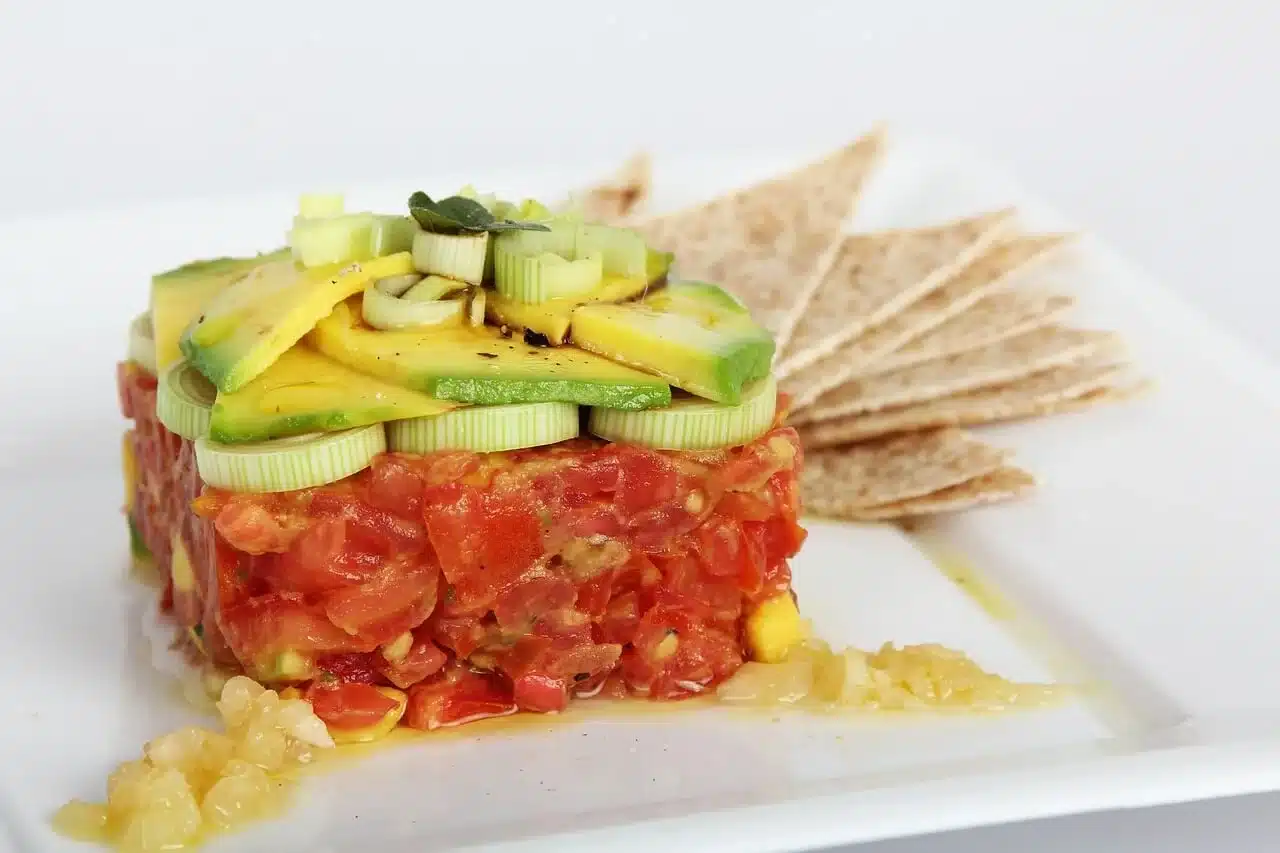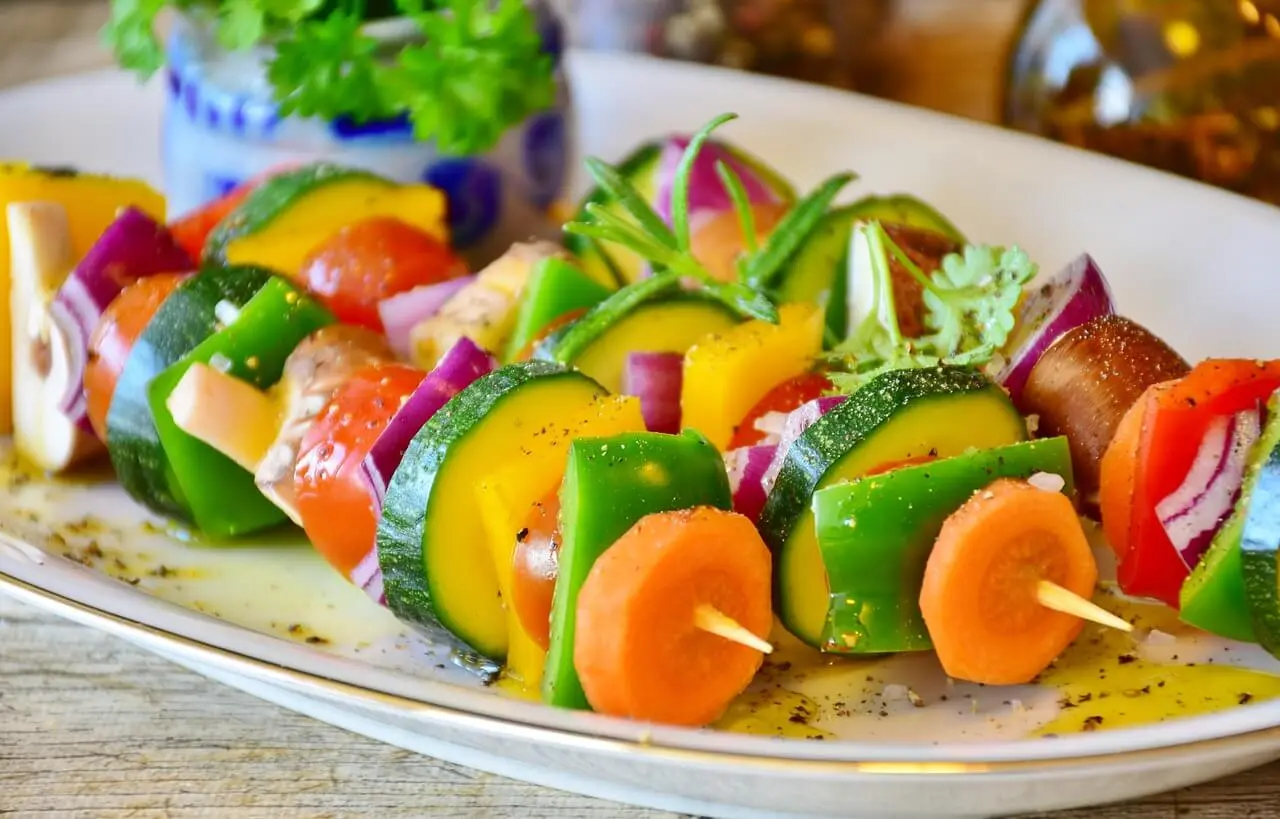Introduction to Vegetarian Cooking
Embarking on a journey through the vibrant world of vegetarian cooking guide is not just about swapping meat with vegetables; it’s a culinary adventure that opens doors to a myriad of flavors, textures, and nutrients. In this ‘Vegetarian Cooking Guide,’ we’ll explore the essentials of finding and preparing delicious vegetarian recipes. From stocking your pantry with must-have ingredients to mastering advanced cooking techniques, and even catering to specialized diets, this article is your go-to resource for all things vegetarian. So, let’s dive in and discover the art of vegetarian cooking!
What is Vegetarian Cooking Guide?
Vegetarian cooking, at its core, is a culinary practice that centers around plant-based ingredients, excluding meat and sometimes other animal products. It’s a creative endeavor that involves exploring a variety of grains, legumes, fruits, and vegetables to create meals that are not only nutritious but also bursting with flavor. The beauty of vegetarian cooking lies in its diversity and adaptability, making it a delightful experience for both seasoned chefs and culinary novices.
Benefits of Vegetarian Meals
Opting for vegetarian meals isn’t just a dietary choice; it’s a lifestyle that offers a plethora of health benefits. Studies have shown that a plant-based diet can reduce the risk of chronic diseases, improve heart health, and aid in weight management. Moreover, vegetarian cooking is kind to the planet, reducing the carbon footprint associated with meat production. It’s a win-win for both your health and the environment!
In the next part, we’ll delve into discovering diverse vegetarian recipes that cater to various tastes and preferences. Stay tuned for a journey through the world of vegetarian cuisine that promises to tantalize your taste buds and nourish your body!
Finding the Right Vegetarian Cooking Recipes

Discovering Diverse Vegetarian Cooking Recipes
Our Vegetarian Cooking Guide continues with a focus on discovering diverse vegetarian recipes. This section provides insights into online resources and cookbooks that are treasure troves of vegetarian recipes
Embarking on your vegetarian journey, the quest for the right recipes can be as exciting as it is daunting. The world of vegetarian cooking is vast and varied, offering a plethora of dishes from simple salads to elaborate entrees. To start, the internet is a treasure trove of recipes. Websites like Nutrition.gov – Eating Vegetarian offer a wealth of information and recipes tailored to vegetarian diets. Additionally, social media platforms, food blogs, and online forums are great places to discover new and trending vegetarian recipes.
Online Resources for Vegetarian Recipes
The digital age makes finding vegetarian recipes a breeze. Websites dedicated to vegetarian cooking, along with apps and online communities, provide endless inspiration. For instance, platforms like Pinterest and Instagram are brimming with mouth-watering vegetarian meal ideas and cooking tips. Don’t forget to check out YouTube channels for step-by-step cooking tutorials that can be especially helpful for beginners.
Vegetarian Cookbooks and Magazines
For those who prefer a more tactile approach, vegetarian cookbooks and magazines are invaluable resources. They not only offer a curated collection of recipes but also provide insights into the nutritional aspects of vegetarian meals. Cookbooks often delve deeper into the art of vegetarian cooking, exploring different cuisines and cooking techniques. Local libraries and bookstores are great places to start your cookbook collection.
In the next part, we’ll explore the essential ingredients that form the backbone of vegetarian cooking. From pantry staples to fresh produce, we’ll cover everything you need to stock your kitchen for delicious vegetarian meals.
Essential Ingredients in Vegetarian Cooking
Must-Have Ingredients for Vegetarian Kitchens
Transitioning to a vegetarian lifestyle means acquainting yourself with a new set of kitchen staples. These essentials form the foundation of countless vegetarian recipes, offering both nutrition and flavor. Key ingredients include a variety of beans and legumes, whole grains like quinoa and brown rice, and a diverse range of spices and herbs. These not only add depth to your dishes but also ensure you’re getting a balanced diet.
Staples of Vegetarian Pantry
A well-stocked vegetarian pantry is your first step towards a successful meatless meal. Beans, lentils, chickpeas, and dried peas are protein-packed and versatile. Whole grains, such as barley, millet, and oats, provide essential fiber and texture. Nuts and seeds, along with their butters, add richness and depth to dishes. Don’t forget the importance of good quality oils, vinegars, and a variety of spices – they’re the secret to turning simple ingredients into culinary masterpieces.
Fresh Produce and Seasonal Varieties
The heart of vegetarian cooking lies in its use of fresh fruits and vegetables. Embracing seasonal produce not only enhances the taste of your meals but also ensures you’re getting the best nutritional value. Vegetables like spinach, kale, and broccoli are nutrient-dense, while fruits like berries, apples, and citrus add a natural sweetness to dishes. Incorporating a colorful array of produce ensures a range of vitamins and minerals in your diet.
In the next part, we’ll guide beginners through easy-to-make vegetarian recipes that are perfect for those just starting out on their vegetarian journey. Simple, delicious, and nutritious – these recipes will set the foundation for your vegetarian cooking.
Vegetarian Recipes for Beginners
Easy-to-Make Vegetarian Recipes for Starters
Diving into vegetarian cooking can be overwhelming for beginners, but fear not! There are countless simple and delicious recipes that are perfect for those just starting out. These dishes require minimal ingredients and basic cooking skills, ensuring a delightful experience in the kitchen. From hearty soups to refreshing salads, the possibilities are endless and cater to all taste preferences.
Simple and Quick Vegetarian Meals
Time is often a constraint when it comes to cooking, but vegetarian meals can be both quick and easy. Dishes like stir-fried vegetables, simple pasta with marinara sauce, and bean salads can be whipped up in no time. These meals are not only filling but also packed with nutrients. For a quick lunch or dinner, try making a vegetable wrap or a classic grilled cheese sandwich with a side of tomato soup.
Step-by-Step Vegetarian Recipes
For those who appreciate a bit more guidance, step-by-step recipes are a great way to build confidence in the kitchen. Look for recipes that provide detailed instructions and photos or videos for each step. Dishes like vegetable stir-fry, basic vegetable curry, and simple bean chili are great starting points. These recipes often involve basic cooking techniques like sautéing, boiling, and baking, which are fundamental skills in vegetarian cooking.
In the next part, we’ll explore the world of international vegetarian cuisine, showcasing the diversity and richness of vegetarian dishes from around the globe. Get ready to take your taste buds on a journey!
International Vegetarian Cuisine
Exploring Global Vegetarian Dishes
Vegetarian cooking is a global affair, with each culture offering its unique twist on meatless meals. This part of the journey takes you around the world, exploring the rich and diverse flavors of international vegetarian cuisine. From the spicy curries of India to the fresh and zesty salads of the Mediterranean, there’s a whole world of vegetarian dishes waiting to be discovered.
Popular Vegetarian Dishes Around the World
Every region has its signature vegetarian dishes that are both delicious and deeply rooted in cultural traditions. In Italy, dishes like Eggplant Parmigiana and Risotto alla Zucca celebrate the simplicity and flavor of fresh ingredients. Indian cuisine offers a plethora of vegetarian options like Chana Masala and Palak Paneer, rich in spices and aroma. Middle Eastern cuisines bring delights such as Falafel and Tabouleh, while Mexican vegetarian cooking includes favorites like Bean Tacos and Veggie Quesadillas.
Fusion in Vegetarian Cooking
Fusion cuisine offers an exciting way to enjoy vegetarian cooking by blending the flavors and cooking techniques of different cultures. It’s about getting creative in the kitchen and experimenting with a variety of ingredients to create something unique and delicious. Think of dishes like Thai-inspired tofu stir-fry, Italian-Mexican fusion bean lasagna, or a Japanese-style vegetable sushi roll. Fusion cooking breaks the boundaries of traditional cuisine and allows for endless creativity in vegetarian cooking.
In the next part, we’ll delve into advanced vegetarian cooking techniques that can elevate your dishes from simple to spectacular. Whether you’re a seasoned cook or looking to expand your culinary skills, these techniques will add a new dimension to your vegetarian meals.
Advanced Vegetarian Cooking Techniques
Mastering Advanced Vegetarian Cooking
For those ready to advance their skills, this part of the ‘Vegetarian Cooking Guide’ delves into sophisticated cooking techniques that can elevate vegetarian dishes to gourmet levels.
Once you’ve got the basics down, it’s time to elevate your vegetarian cooking with some advanced techniques. These methods can add complexity and depth to your dishes, turning simple ingredients into gourmet meals. From perfecting the art of roasting vegetables to mastering the balance of flavors, these techniques will enhance your cooking repertoire.
Techniques for Texture and Flavor
The key to exceptional vegetarian cooking lies in understanding how to manipulate texture and layer flavors. Techniques like caramelizing onions to bring out their natural sweetness, roasting nuts for a crunchy topping, or marinating tofu for depth of flavor are essential. Experimenting with herbs and spices, and learning to balance the five taste elements (sweet, sour, salty, bitter, and umami) can transform your dishes. Don’t be afraid to try techniques like smoking vegetables or making homemade vegetable stock for added flavor.
Presentation and Plating of Vegetarian Dishes
They say we eat with our eyes first, and this is especially true in vegetarian cooking, where the natural colors of vegetables can create stunning visual appeal. Learning the art of plating can make your dishes not only taste delicious but also look exquisite. Focus on color contrasts, use fresh herbs for garnish, and experiment with different textures. A well-presented dish enhances the overall dining experience and can turn a simple meal into a special occasion.
In the next part, we’ll explore how to cater to specialized diets within vegetarian cooking, such as gluten-free and vegan options. This will ensure that your vegetarian cooking is inclusive and enjoyable for everyone, regardless of dietary restrictions.
Specialized Vegetarian Diets
Catering to Special Dietary Needs
Vegetarian cooking is incredibly versatile, allowing it to easily adapt to various dietary requirements and preferences. Whether it’s gluten-free, vegan, or allergy-friendly options, there’s a wealth of possibilities to explore. This part focuses on how to modify and create vegetarian recipes that cater to these specialized diets without compromising on taste or nutrition.
Gluten-Free and Vegan Options
For those avoiding gluten, vegetarian cooking can be a haven, as many plant-based foods are naturally gluten-free. Key ingredients include quinoa, rice, and gluten-free flours like almond or chickpea flour. Vegan cooking, which excludes all animal products, relies on plant-based proteins like lentils, tofu, and tempeh, and dairy alternatives such as almond milk and coconut yogurt. The trick is to find substitutes that not only mimic the texture but also enhance the flavor of the dish.
Allergy-Friendly Vegetarian Recipes
Creating allergy-friendly vegetarian dishes involves being mindful of common allergens like nuts, soy, and dairy. Fortunately, there are numerous alternatives available. Nut allergies can be accommodated by using seeds like sunflower or pumpkin seeds. For those allergic to soy, look to beans and grains as protein substitutes. Dairy can be replaced with a variety of plant-based milks and cheese alternatives. The key is to be creative and open to experimenting with new ingredients.
In the next part, we’ll wrap up our comprehensive guide to vegetarian cooking with a summary of key points and additional resources. This will provide a quick reference and further reading to continue your vegetarian culinary journey.
FAQs on Finding Vegetarian Recipes
In this section, we address some common queries and concerns about finding and preparing vegetarian recipes. These FAQs are designed to help both beginners and seasoned cooks navigate the world of vegetarian cooking with ease.
Common Queries About Vegetarian Cooking
- How do I ensure a balanced diet as a vegetarian?
- A balanced vegetarian diet includes a variety of fruits, vegetables, grains, proteins (like beans and lentils), and healthy fats. It’s important to include a range of foods to ensure you’re getting all necessary nutrients.
- Can vegetarian meals be protein-rich?
- Absolutely! Foods like lentils, chickpeas, tofu, tempeh, and quinoa are excellent sources of protein for vegetarians.
- Is vegetarian cooking time-consuming?
- Not necessarily. Many vegetarian dishes are quick and easy to prepare. Planning and meal prepping can also save time.
- How can I make my vegetarian meals more flavorful?
- Don’t shy away from using a variety of herbs, spices, and seasonings. Experiment with different cooking techniques like roasting or grilling to enhance flavors.
- What are some essential vegetarian pantry staples?
- Key staples include whole grains, a variety of beans and legumes, nuts and seeds, and a good stock of spices and condiments.
Tips and Tricks for Vegetarian Recipes
- Experiment with International Cuisines: Many cultures have a rich history of vegetarian cooking. Exploring these cuisines can add variety to your meals.
- Incorporate Seasonal Produce: Using seasonal fruits and vegetables can enhance the flavor and nutritional value of your meals.
- Get Creative with Leftovers: Transform leftovers into new meals to reduce waste and keep your diet interesting.
- Try Meat Substitutes: If you’re missing the texture of meat, experiment with meat substitutes like seitan, tempeh, or textured vegetable protein.
- Attend Cooking Classes or Workshops: These can be great for learning new recipes and techniques, and for meeting fellow vegetarian cooking enthusiasts.
Conclusion and Additional Resources
Wrapping Up Our Vegetarian Cooking Journey
As we reach the end of our comprehensive guide to vegetarian cooking, it’s evident that embracing a vegetarian lifestyle is both a nutritious and delicious choice. We’ve covered a range of topics, from the basics of stocking a vegetarian pantry to exploring international cuisines and accommodating specialized diets. The versatility and creativity in vegetarian cooking make it an endlessly rewarding experience, one that benefits both your health and the environment.
Summary of Key Points
- Vegetarian Cooking Guide Basics: Understanding the essentials of vegetarian cooking, including pantry staples and fundamental cooking techniques.
- Diverse Recipes and International Flavors: Exploring a wide range of vegetarian recipes from around the world to add variety to your meals.
- Advanced Techniques and Presentation: Elevating your cooking with advanced techniques and focusing on the visual appeal of your dishes.
- Specialized Diets: Adapting vegetarian cooking to meet various dietary needs, ensuring inclusivity and enjoyment for all.
Additional Resources and Websites
To continue your vegetarian cooking journey, here are some additional resources:
- American Diabetes Association – Vegan Meal Planning: A great resource for understanding how to plan balanced vegan meals, especially useful for those managing diabetes.
- Nutrition.gov – Eating Vegetarian: Offers a wealth of information on vegetarian diets, including nutritional advice and recipe ideas.
- Johns Hopkins Medicine – Balanced Diet as a Vegetarian: Provides insights into maintaining a balanced diet while following a vegetarian or vegan lifestyle.
Remember, the journey to mastering vegetarian cooking is an ongoing adventure. There’s always something new to learn, whether it’s a recipe, a technique, or an ingredient. Embrace the journey with an open mind and a willing palate, and enjoy the delicious rewards of your culinary explorations.
Thank you for joining us on this delightful journey through vegetarian cooking! We hope this guide inspires you to explore the rich and varied world of vegetarian cuisine.


11 thoughts on “Vegetarian Cooking Guide: Essentials & Global Recipes for All”